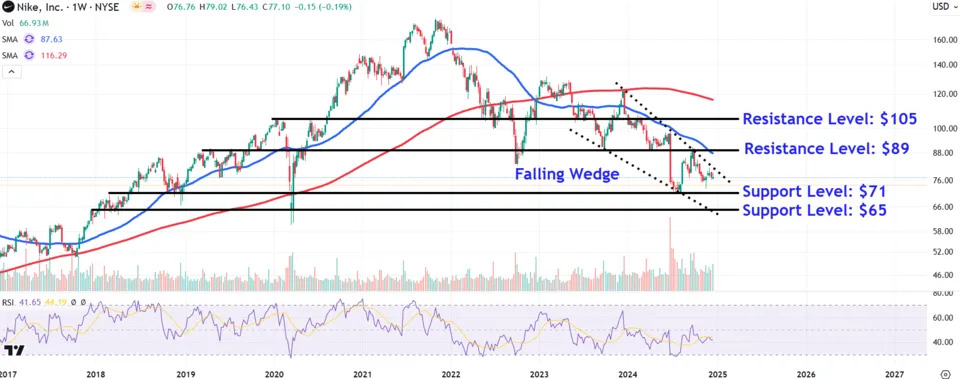Watch These Nike Stock Price Levels as Strategy Shift Weighs on Outlook

Key Takeaways
Nike ( NKE ) shares lost ground Friday morning after the sports equipment and apparel reported quarterly results that topped Wall Street’s estimates but provided an outlook that came in below expectations, as the company undergoes an ambitious strategy shift.
The company anticipates current quarter revenue to contract by low double digits from a year earlier. CEO Elliott Hill, who assumed the role in October, said on Nike's earnings call late Thursday that the company plans to refocus on sports and selling more items at premium prices, but cautioned that the turnaround will take time and weigh on short-term results.
Nike shares have lost nearly 30% of their value since the start of the year amid intensifying competition in both domestic and international markets that has eroded its market share . The stock was down slightly at $77 in midday trading Friday, after falling below $75 early in the session.
Below, we break down the technicals on Nike’s weekly chart to identify key post-earnings price levels investors may be watching.
Falling Wedge Pattern in Focus
Nike share have traded within a 15-month falling wedge , a chart pattern consisting of two converging downward sloping trendlines that often precedes an upward breakout .
More recently, the stock has consolidated just below the formation’s upper trendline, signaling indecision ahead of the company’s quarterly report.
Let’s take a closer look at Nike’s chart to identify major support and resistance levels that may attract further attention.
Major Support Levels to Watch
Selling below current levels could see the shares fall to around $71, a location on the chart where they may encounter support near a horizontal line that joins a range of similar price points on the chart between February 2018 and July this year.
A breakdown below this important technical area opens the door for a drop to long-term support at the $65 level. Investors could seek bargain hunting opportunities in this region near a consolidation period that formed on the chart in late 2017 and early 2018, which also aligns with the opening prices of several wide-ranging days that marked the March 2020 pandemic low.
Key Resistance Levels to Observe
A breakout above the falling wedge pattern’s upper trendline could propel a move to around $89. This area finds a confluence of resistance from a multi-month trendline that connects multiple peaks and troughs on the chart from March 2019 to September this year with the nearby 50-week moving average.
Further upside may see the shares rally to the $105 level. Investors who purchased the stock at lower prices may look for exit points near a trendline that links the January and June 2020 peaks with a range of comparable price action on the chart between May 2022 and February this year.
The comments, opinions, and analyses expressed on Investopedia are for informational purposes only. Read our warranty and liability disclaimer for more info.
As of the date this article was written, the author does not own any of the above securities.
Read the original article on Investopedia

